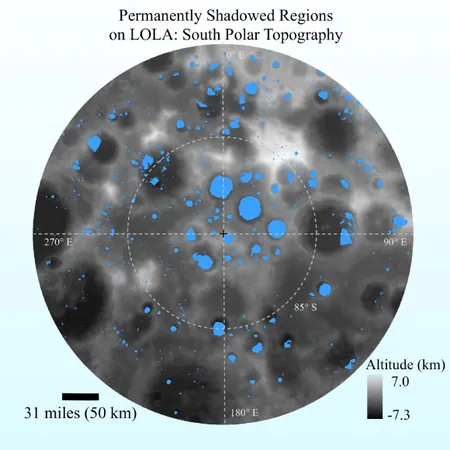
New Discoveries Reveal Extensive Lunar Ice Deposits Beyond the South Pole
2024-10-03
Author: Jia
Introduction
Recent analyses have unveiled that the Moon's icy secrets run deeper than previously believed, extending well beyond the commonly studied permanently shadowed regions (PSRs) near its south pole. Historically, researchers identified signs of ice predominantly within specific craters—Cabeus, Haworth, Shoemaker, and Faustini. However, new data from NASA's Lunar Reconnaissance Orbiter (LRO) indicates the presence of water ice in PSRs that stretch towards 77 degrees south latitude, suggesting a far more extensive reservoir of lunar ice than initially thought.
Origins of Lunar Ice
The origins of this ice are intriguing; it may have been implanted in the lunar regolith due to impacts from comets and meteors, released as vapor from the Moon's interior, or formed through chemical reactions involving the hydrogen found in the solar wind and the oxygen within the regolith itself.
Permanently Shadowed Regions
These PSRs, which primarily occur in depressions near the lunar poles, have been shrouded in darkness for potentially billions of years. The low-angle sunlight means that these regions are trapped in extreme cold, creating perfect conditions for preserving ice. As ice molecules are displaced by meteorite impacts, space radiation, or sunlight, they can wander across the lunar surface until they become trapped in these shadowy areas, where the chilling temperatures can lead to significant ice accumulation over geological timescales.
Research Insights
Dr. Timothy McClanahan from NASA’s Goddard Space Flight Center shed light on the findings, indicating that the highest concentrations of ice are expected in locations below 75 Kelvin (approximately -198 degrees Celsius or -325 degrees Fahrenheit) and on the poleward-facing slopes of these PSRs. While the volume of ice deposits remains uncertain, researchers project that each square meter of surface above these deposits contains roughly five liters more ice within the top meter compared to surrounding regions.
Detection Techniques
Using the LRO's Lunar Exploration Neutron Detector (LEND), researchers detected signs of ice by measuring moderate-energy neutrons. This sophisticated instrument includes the Collimated Sensor for Epithermal Neutrons (CSETN), which has a fixed 30-km diameter field of view. High-energy galactic cosmic rays, originating from events such as supernovae, collide with the lunar surface and break apart atoms in the regolith, scattering neutrons in the process.
Neutron Interaction
When these neutrons collide with hydrogen, which is abundant in the water ice, they lose energy more significantly than they do with other regolith elements, allowing researchers to infer the presence of hydrogen by observing alterations in neutron levels. Dr. McClanahan stated, “We hypothesized that if all PSRs have the same hydrogen concentration, then CSETN should proportionally detect their hydrogen concentrations as a function of their areas. Thus, we expect to see greater hydrogen signatures in larger PSRs.”
Future Implications
This exciting research was documented in the latest issue of the Planetary Science Journal, paving the way for future explorations focused on the Moon's resources. As missions to the Moon evolve, the potential for mining these ice deposits could revolutionize space travel, making lunar bases feasible for future, deeper space exploration.
Conclusion
Stay tuned for updates as we continue to explore the implications of these groundbreaking findings!



 Brasil (PT)
Brasil (PT)
 Canada (EN)
Canada (EN)
 Chile (ES)
Chile (ES)
 España (ES)
España (ES)
 France (FR)
France (FR)
 Hong Kong (EN)
Hong Kong (EN)
 Italia (IT)
Italia (IT)
 日本 (JA)
日本 (JA)
 Magyarország (HU)
Magyarország (HU)
 Norge (NO)
Norge (NO)
 Polska (PL)
Polska (PL)
 Schweiz (DE)
Schweiz (DE)
 Singapore (EN)
Singapore (EN)
 Sverige (SV)
Sverige (SV)
 Suomi (FI)
Suomi (FI)
 Türkiye (TR)
Türkiye (TR)